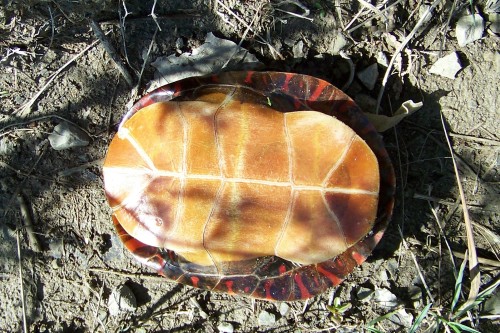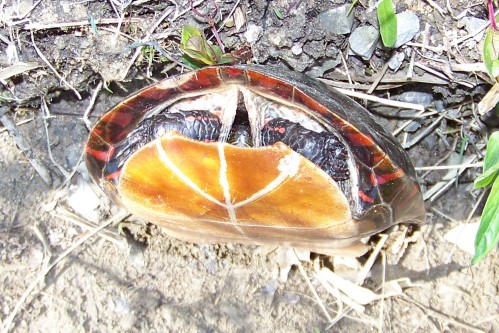
June is turtle season in Ontario. This is the time of year when turtles are most often seen as they travel to their nesting sites. Unfortunately, “hitting the road” can sometimes be all too literal for turtles as they risk their lives crossing roads. I spotted the above Painted Turtle (Chrysemys picta marginata) in the middle of the road, apparently basking in the sun. When I got out of my car to move (probably) her, she quickly withdrew into her shell. Painted turtles are about 11 to 14 centimeters long, with females larger than males. As this turtle was at the top end of that range, it was likely a female. I set her down in vegetation at the side of the road she had been heading towards.
Since she was being so co-operative, I snapped a few pictures before leaving her in peace. You’d think a “painted” turtle might have a more colourful shell, but it is just the margin of the carapace (upper shell) and the red and yellow striping of the legs and neck that give the turtle its name. The individual sections of the carapace are called scutes. The lower shell is called the plastron. Painted Turtles are noted for their habit of basking in the sun, sometimes lining up together on partially submerged logs. Northern turtles survive the winter by hibernating in the mud of ponds or streams. Painted turtles can survive without oxygen while hibernating for up to five months, longer than any other known air-breathing vertebrate.

There are eight species of turtles in Ontario. The Painted Turtle is the most common and widespread species. Snapping Turtles (Chelydra serpentina) are still present in significant numbers but are vulnerable in some areas where populations were once stronger. The remaining 6 species (Blanding’s, Musk or Stinkpot, Map, Spotted, Spiny Softshell, and Wood) are all in trouble, listed as threatened or endangered. Threats to turtles include the loss of wetland habitat, road mortality, pollution, collection as pets, and predation. These pressures may soon overwhelm these important wetland ecosystem members.
If you see a turtle on the road, you can stop and help it across the road, or direct traffic until it makes it on its own. For more on helping turtles cross the road, check out Outside Up North. You can contribute to knowledge about turtle numbers and movement by reporting sightings to the Ontario Turtle Tally.
